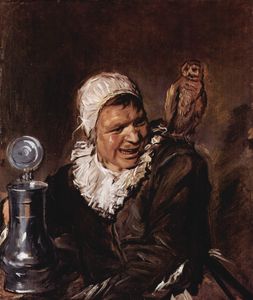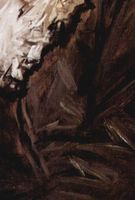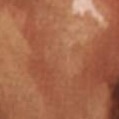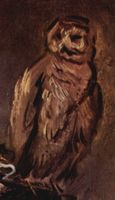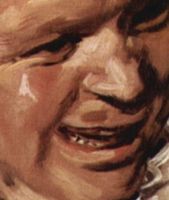Malle Babbe Analysis
- Date of Creation:
- 1633
- Alternative Names:
- The Haarlem Witch, Hille Bobbe
- Height (cm):
- 75.00
- Length (cm):
- 64.00
- Medium:
- Oil
- Support:
- Canvas
- Subject:
- Figure
- Art Movement:
- Baroque
- Created by:
- Current Location:
- Berlin, Germany
- Displayed at:
- Gemäldegalerie Berlin
- Owner:
- Gemäldegalerie Berlin
- Malle Babbe Analysis Page's Content
- Introduction
- Composition
- Use of color
- Mood, Tone and Emotion
- Brushstroke
Introduction
This work is believed to be Hals' most well-defined character pieces. At the time he created Malle Babbe he was already notorious for his character portraiture and had already perfected the art of capturing personality. His painting style is also at its most mature as he is seen freely expressing himself upon this canvas. His painting style and subject are actually more in keeping with Impressionism of the 19th century.
Malle Babbe Composition
The composition of this work is tight in order to convey the overcrowded tavern. Besides the candle which flickers due to passersby, the old woman is situated near the wall, almost right up against it. The overbearing shadows to the top create a sense of claustrophobia.
The objects placed in the image also help to make Malle Babbe the focus of the painting. Our gaze is directed toward her by the tankard in the foreground. Babbe's face also leads the eye to the owl upon her shoulder, and the owl in turn looks toward Babbe redirecting our gaze.
Hals also implies that Malle Babbe is looking on toward another person outside the image. She seems deep conversation and the other person cannot be sitting too far as she seems comfortable and they can be clearly heard.
Malle Babbe Use of color
Hals uses white loosely to define light upon the colors in the picture. However, it is the use of browns that dominate this canvas as Hals uses multi-layering in the fabric folds of Malle Babbe's dress; he even uses it in the tankard to create reflection on the surface.
The artist uses strong strokes of brown to add depth and movement. Darker browns in harsh overtones are used to create the shadow on the wall behind the subject as well.
For the subject's skin, Hals boldly uses a slight tint of red for her flushed cheeks and various light brown tones. He uses white over layering to create definition and the light creates creases on her face. Brown tones create harsher lines around her mouth in particular, portraying a crooked smile.
Malle Babbe Mood, Tone and Emotion
Hals had chosen to insert the image of an owl upon the woman's shoulder to accentuate the character of Malle Babbe and to emphasize her personality.
The owl serves as antithesis to the conventional symbol for insight and wisdom, as it lies within a different context. Here it represents the ancient folklore of witchcraft and drunkenness, as it comes to symbolize being active in the night just as Malle Babbe's crude character was. In the day time the bird is slow and inefficient, just as Malle Babbe's persona as she was definitely a creature of the night.
The owl also denotes erotic behavior as it is a symbol of the night and represents darkness, a time when daytime formalities are broken and people are more relaxed.
Malle Babbe was a voluptuous woman in her heyday and she was governed by her body and sexuality with few inhibitions. The owl was therefore also a representation of her, as the owl tends to lure it prey, just as Babbe lured men.
One of the strongest aspects to her character is the detailing on her face, defined by the dim lighting. Her nose is pointed and sharp and stands out against her aging face and weakened features. Her eyes are not shaped or defined but instead appear as two dark pits which adds to her unattractiveness in Hal's depiction.
Malle Babbe Brushstroke
This work shows Hals' spontaneity through his suggestive brush work. He looks to separate the concept of the picture and reality by inserting blurry yet strong strokes and blatant daubing to evoke emotion.
Hals' strokes are hard and brash due to his erratic use of the brush.
This technique also captures the buzz inside the tavern itself, as the nightlife becomes rowdy and chaotic. It seems that Hals worked at a fast pace as his strokes of color are layered and these stand out and create a sense of movement in the image. Hal's stark and bright use of colors for layering also capture the points where the light touches the fabrics.
The brush work coincides with the environment as bold and quick strokes add movement to match the flickering nearby lamp. The artist's daubed and ruffled background also shows movement surrounding the subject as passers by cause the light to bend.
This work has no close attention to detail like Hals' other commissioned works where the patron's tastes and preference overrode his freedom for expression. The owl is defined by prominent black lines and is poorly executed on the whole. Malle Babbe's face is defined by the light emitting from the left side and stark shadows highlight her finer facial lines and wrinkles, showing the soft texture of her aging skin.
Overall, the brush work in Malle Babbe is loose and fluid and tis conjures up an image of the tavern as cosy, if not overcrowded and filled with a smoky haze that generated warmth among customers.

